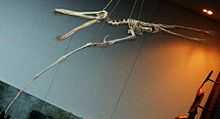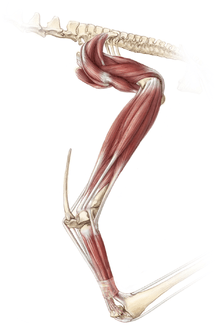Anhanguera (pterosaur)
| Anhanguera Temporal range: Early-Late Cretaceous, 112–94Ma | |
|---|---|
| | |
| A. blittersdorffi skull, Natural History Museum, London | |
| Scientific classification | |
| Kingdom: | Animalia |
| Phylum: | Chordata |
| Order: | †Pterosauria |
| Family: | †Anhangueridae |
| Subfamily: | †Anhanguerinae Campos & Kellner, 1985 |
| Genus: | †Anhanguera Campos & Kellner, 1985 |
| Type species | |
| Anhanguera blittersdorffi Campos & Kellner, 1985 | |
| Species | |
| |
Anhanguera (meaning "old devil") is a genus of pterodactyloid pterosaur known from the Lower-Cretaceous (Aptian age, 112Ma) Santana Formation of Brazil, with referred specimens found in the Upper Chalk Formation and Cambridge Greensand of the UK (up to the late Cenomanian age, 94Ma). This pterosaur is closely related to Ornithocheirus, and belongs in the family Ornithocheiridae within its own subfamily, Anhanguerinae.[1]
Description

Anhanguera was a fish-eating animal with a wingspan of about 4.5 m (15 ft). Like many other ornithocheirids, Anhanguera had a rounded crests at front of its upper and lower jaws, which were filled with angled, conical but curved teeth of various sizes and orientations. Like many of its relatives, the jaws were tapered in width, but expanded into a broad, spoon-shaped rosette at the tip. It is distinguished from its relatives by subtle differences in the crest and teeth: unlike its close relatives Coloborhynchus and Ornithocheirus, the crest on the upper jaw of Anhanguera did not begin at the tip of the snout, but was set farther back on the skull. Like many ornithocheiroids, (most notably the pteranodonts but also in ornithocheirids such as Ludodactylus) Anhanguera had an additional crest protruding from the back of the skull. However, it was reduced to a small, blunt projection in these animals.[2]
A study in 2003 showed that Anhanguera held its head at an angle to the ground due to its inner ear structure, which helped the animal detect its balance.[3]
Classification and species
There are several recognized species of Anhanguera. A. santanae and A. blittersdorfi are known from several fragmentary remains including skulls from the Santana Formation of Brazil. A. cuvieri and A. fittoni, initially described as belonging to the genus Pterodactylus and then Ornithocheirus, are from a slightly later period (Albian) from England, while fragments of pterosaurs that may have affinities with Anhanguera have also been found in Queensland, Australia. The well-known species A. piscator has been redescribed as belonging to the genus Coloborhynchus (Veldmeijer, 2003).
List of species and synonyms



Species which have been assigned to Anhanguera by various scientists since 2000 include:
- ?A. cuvieri (Bowerbanks 1851) = Ornithocheirus cuvieri = Pterodactylus cuvieri Bowerbank 1851 [now classified as Cimoliopterus]
- ?A. fittoni (Owen 1858) = Pterodactylus fittoni Owen 1858
- ?A. araripensis[4] (Wellnhofer 1985) = Santanadactylus araripensis Wellnhofer 1985 [also classified as Coloborhynchus]
- A. blittersdorffi Campos & Kellner 1985 type species [also classified as Coloborhynchus]
- A. santanae (Wellnhofer 1985) = Araripesaurus santanae Wellnhofer 1985
- ?A. robustus (Wellnhofer 1987) = Tropeognathus robustus Wellnhofer 1987 [also classified as Coloborhynchus]
- ?A. ligabuei (Dalla Vecchia 1993) = Cearadactylus ligabuei Dalla Vecchia 1993 [also classified as Coloborhynchus or Cearadactylus]
- ?A. piscator Kellner & Tomida 2000 [also classified as Coloborhynchus]
- ?A. spielbergi[4] Veldmeijer 2003 [also classified as Coloborhynchus]

Below is a cladogram showing the phylogenetic placement of this genus within Pteranodontia from Andres and Myers (2013).[5]
| Pteranodontia |
| |||||||||||||||||||||||||||||||||||||||||||||||||||||||||||||||||||||||||||||||||||||||||||||||||||||||||||||||||||||||||||||||||||||||||||||
| |
Cultural references
Life-sized models of three Anhanguera are suspended as if in flight over the Terror of the South exhibit on the third floor of the North Carolina Museum of Natural Sciences.
References
- ↑ Campos, D. de A., and Kellner, A. W. (1985). "Un novo exemplar de Anhanguera blittersdorffi (Reptilia, Pterosauria) da formaçao Santana, Cretaceo Inferior do Nordeste do Brasil." In Congresso Brasileiro de Paleontologia, Rio de Janeiro, Resumos, p. 13.
- ↑ Kellner, A.W.A. and Tomida, Y. (2000). "Description of a new species of Anhangueridae (Pterodactyloidea) with comments on the pterosaurfauna from the Santana Formation (Aptian–Albian), northeastern Brazil." Tokyo, National Science Museum (National Science Museum Monographs, 17).
- ↑ Witmer, L.M., Chatterjee, S., Franzosa, J. and Rowe, T. (2003). "Neuroanatomy of flying reptiles and implications for flight, posture and behaviour." Nature, 425(6961): 950-954. doi:10.1038/nature02048
- ↑ 4.0 4.1 Veldmeijer, A.J. (2003). "Description of Coloborhynchus spielbergi sp. nov. (Pterodactyloidea) from the Albian (Lower Cretaceous) of Brazil." Scripta Geologica, 125: 35-139.
- ↑ Andres, B.; Myers, T. S. (2013). "Lone Star Pterosaurs". Earth and Environmental Science Transactions of the Royal Society of Edinburgh: 1. doi:10.1017/S1755691013000303.
- Campos, D. A., and Kellner, A. W. A. (1985). "Panorama of the Flying Reptiles Study in Brazil and South America (Pterosauria/ Pterodactyloidea/ Anhangueridae)." Anais da Academia Brasileira de Ciências, 57(4):141–142 & 453-466.
- T. Rodrigues and A. W. A. Kellner. (2008). Review of the pterodactyloid pterosaur Coloborhynchus. Zitteliana B 28:219-228.